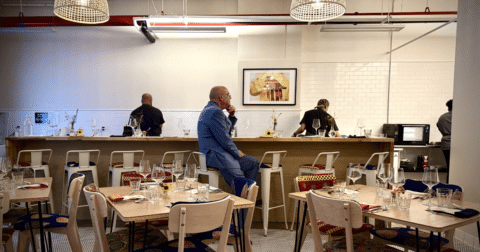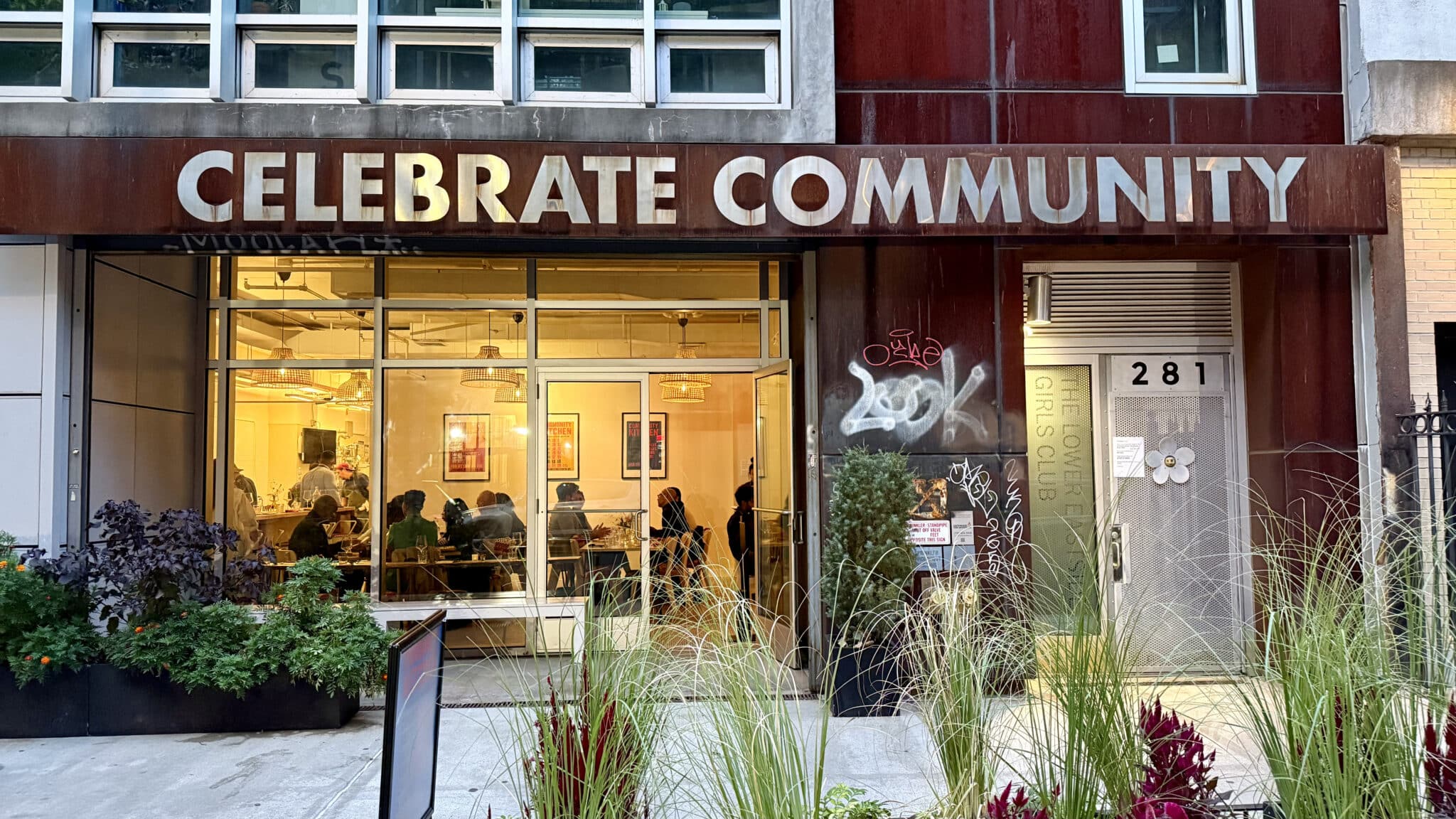Feature
Georgia Communities Are Pushing Back Against Big Chicken
Food•7 min read
Solutions
An experiment in public dining is challenging the idea that good food should be a luxury.


Words by Gabriella Sotelo
Tucked into the Lower East Side of New York City, Community Kitchen isn’t a typical restaurant. The new nonprofit dining space aims to reimagine what it means to eat well, and who gets to do so. Conceived of nearly five years ago, Community Kitchen is the brainchild of Mark Bittman, author of the “How to Cook Everything” cookbook series and founder of the Bittman Project. Bittman saw a fundamental flaw in the food system: While high-end restaurants can serve nutritious food, treat workers fairly and source responsibly, they are still exclusive spaces, inaccessible to most people.
For that to change, Bittman argues, the profit motive has to be removed altogether. “You have to be willing to lose money if you want to make good food accessible to everyone,” he says. To that end, diners pay for their meal according to a sliding scale, rather than set prices on a menu.
To bring this vision to life, Bittman assembled a team of food justice leaders, chefs, hospitality experts and policy strategists to launch a restaurant that would challenge the status quo — from pricing and sourcing to labor and service. Together, they identified five core pillars that redefine what “good food” means. The pilot restaurant officially launched on September 19.
The U.S. food system is a study in contradictions: food is everywhere, yet millions go hungry or malnourished. According to the U.S. Department of Agriculture, 47.4 million people lived in food-insecure households in 2023. The USDA defines food insecurity as “limited or uncertain availability” of nutritious foods.
This crisis appears to be escalating. The American diet continues to be dominated by unhealthy ultra-processed foods (foods that are high in sugar, fat and/or salt). On top of this, the Trump administration’s $186 billion in cuts to SNAP means millions of Americans are at risk of losing critical food assistance.
Meanwhile, in New York City, nearly one in four residents struggles to afford food. On paper, some neighborhoods appear well-stocked with food, points out chef Mavis-Jay Sanders, who is the culinary director of Community Kitchen. But looks can be deceiving. Zoom in on a map, and it seems like there’s a grocery store every few blocks. In reality Sanders says it’s mostly bodegas filled with far more snacks and sodas than whole foods. For example, a 2022 CBS investigation found that across the five boroughs of New York City, 10 neighborhoods had more than 25 bodegas for every supermarket, and nearly 20 neighborhoods had a ratio of at least 15 bodega to one supermarket.
This is what some advocates describe as a food swamp: a neighborhood where unhealthy options far outnumber nutritious ones. And these conditions don’t arise by accident. Advocates point to what they call food apartheid, a term that highlights how systemic racism, redlining and disinvestment have deliberately shaped these conditions. If food swamps are the result, food apartheid describes the system that created them.
“The biggest failure of our food system is that the food that’s most affordable is killing people,” says Sanders. “How we are addressing that is finding a way to feed people with food that’s going to nourish their bodies.”
But the harm is more than what ends up on people’s plates, and it’s perpetuated throughout the food system, Community Kitchen executive director Rae Gomes tells Sentient. “Because our food system has always been profit-based — starting from slavery — we decided that we were going to maximize profit,” Gomes says. “When that became no longer viable, we created capitalism. Every single person who works in the food system is taken advantage of. So the way Community Kitchen seeks to — in a very small but hopefully significant way — to change that is by not centering profit.”

In other words, food insecurity is about much more than hunger. The USDA defines it narrowly as a lack of consistent access to enough food — but that definition captures only part of the reality. Food insecurity is also a matter of inequality, exploitation and exclusion.
This is the broken system that Community Kitchen seeks to disrupt.
Community Kitchen was designed to test what happens when accessibility and community aren’t afterthoughts, but starting points. Every element of the experience, from the menu to the staffing model, is structured broadly around five pillars: good sourcing, dignified labor, fresh and nutritious food, affordability and community. These pillars are intended to serve as a new standard for what “good food” should mean.
Sourcing starts with relationships. The team works directly with local, marginalized farmers in order to build a more just supply chain that centers sustainability and equity. Inside the restaurant, those values extend to the team. In an industry notorious for low wages and instability, Community Kitchen offers living wages and prioritizes the local community.
“When you don’t have to pay attention to profit, you get to pay attention to so many other important things,” Gomes said. “You get to pay attention to taking care of people, making sure that the food is high quality and good for you, and making sure that people are comfortable.”
Every meal is cooked from scratch using mostly local, seasonal ingredients. One dish Sanders mentioned experimenting with was whole wheat steamed buns packed with collard greens. The idea is to cook dishes that draw from cultural traditions in the neighborhood using local ingredients. Corn is turned into corn silk tea and corn pudding. On the plate, the food is fresh, nutritious and designed to be joyful.
“There’s an excitement of people who are in the building about the food and about where it’s coming from, the love and the process that goes into it,” Sanders says.
Here, quality isn’t reserved for an elite few. It’s made accessible by design.

Instead of setting fixed prices, Community Kitchen uses a sliding scale model — $15, $45 or $125 per meal — allowing those with more to help cover the cost for those with less. Diners simply pay what they can. There’s no paperwork, no proof of income. “Restaurants and food were supposed to be about places where people could come and be taken care of, and sit down and be nourished and have good conversation,” Sanders describes. “We’ve gotten so far away from that, and it tends to be just transactional.” They are working to revive the idea that food spaces can be places of care and of community, which is the last pillar.
Community Kitchen wants to create a space of connection and care. That means collaborating with local partners like the Lower East Side Girls Club, where the restaurant will be located, and canvassing the neighborhood and inviting feedback at every step.
Community Kitchen is launching as a small, three-month pilot, but Bittman and the team hope it can serve as proof of concept for what a better food system could look like.
That vision isn’t without precedent. The project draws inspiration from Brazil’s Popular Restaurant initiative, launched by the city government of Belo Horizonte to combat food insecurity. These government-supported “People’s Restaurants” serve affordable, balanced meals, often for the equivalent of just one dollar, using ingredients sourced from local family farms.
For the project to scale here, you need money, and both Bittman and Gomes say this is the kind of project that would benefit from federal funding. Sourcing local and sustainable ingredients, preparing healthy meals and building community should be subsidized, Gomes says. And the federal government has money, Bittman argues, adding that “this isn’t a pipe dream.”

During this test run, Gomes says the team is closely tracking how well they uphold each of their five core pillars, working with a research and evaluation firm on an evaluation process that will run through March. In the meantime, during the restaurant’s opening phase, they’re hosting focus groups and creating opportunities to bring people together to gather feedback.
Ultimately, success isn’t just about data points, members of the team tell Sentient. It’s about the experience they offer every person who walks through the door. “I think when people say our name and they smile,” says Sanders, “ that’s when we’ll know we were successful.”